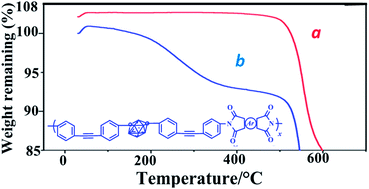Carborane polyimides, synthesis and characterization†
Abstract
Here we report the syntheses of polyimides with meta-carborane cages embedded in the polymer chain and their characterizations. Aromatic carborane diamines were prepared by a Sonogashira reaction in the first place; reaction of the obtained diamines with commercially available dianhydride led to the formation of carborane polyimides with high molecular weight. Thermogravimetric analysis (TGA) of the samples showed that they have excellent thermal stability, with 5 wt% decomposition temperatures (Td5%) higher than 520 °C. Due to the boron-rich nature of the obtained polyimides, samples prepared here have potential applications in the aerospace industry and nuclear power stations as building blocks for neutron shielding and detecting devices.


 Please wait while we load your content...
Please wait while we load your content...